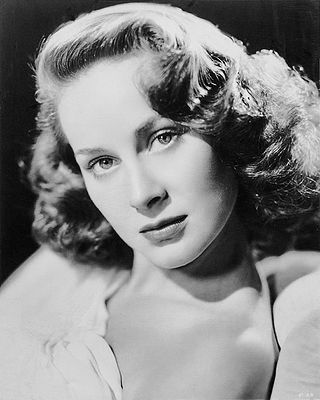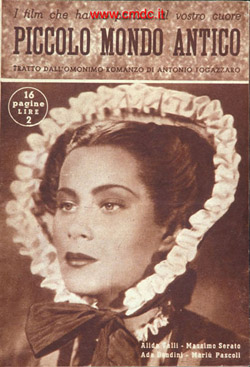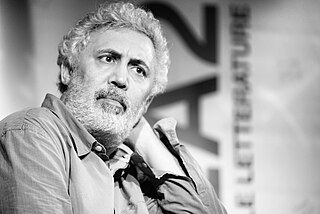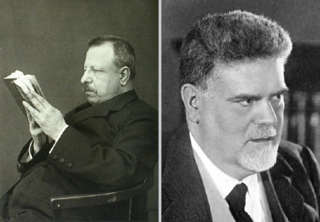Related Research Articles

Don Camillo and Peppone are the fictional protagonists of a series of works by the Italian writer and journalist Giovannino Guareschi set in what Guareschi refers to as the "small world" of rural Italy after World War II. Most of the Don Camillo stories came out in the weekly magazine Candido, founded by Guareschi with Giovanni Mosca. These "Little World" stories amounted to 347 in total and were put together and published in eight books, only the first three of which were published when Guareschi was still alive.

Piero della Francesca was an Italian painter, mathematician and geometer of the Early Renaissance, nowadays chiefly appreciated for his art. His painting is characterized by its serene humanism, its use of geometric forms and perspective. His most famous work is the cycle of frescoes The History of the True Cross in the Basilica of San Francesco in the Tuscan town of Arezzo.

Antonio Fogazzaro was an Italian novelist and proponent of Liberal Catholicism. He was nominated for the Nobel Prize in Literature seven times.
The Saint may refer to:

Benedetto Croce, OCI, COSML was an Italian idealist philosopher, historian, and politician who wrote on numerous topics, including philosophy, history, historiography, and aesthetics. A political liberal in most regards, he formulated a distinction between liberalism and "liberism". Croce had considerable influence on other Italian intellectuals, from Marxists to Italian fascists, such as Antonio Gramsci and Giovanni Gentile, respectively.

Antonio Tabucchi was an Italian writer and academic who taught Portuguese language and literature at the University of Siena, Italy. Deeply in love with Portugal, he was an expert, critic and translator of the works of Fernando Pessoa from whom he drew the conceptions of saudade, of fiction and of the heteronyms. Tabucchi was first introduced to Pessoa's works in the 1960s when attending the Sorbonne. He was so charmed that when he returned to Italy, he took an introductory course in Portuguese for a better comprehension of the poet.

Alida Maria Laura, Freiin Altenburger von Marckenstein-Frauenberg, better known by her stage name Alida Valli, was an Italian actress who appeared in more than 100 films in a 70-year career, spanning from the 1930s to the early 2000s. She was one of the biggest stars of Italian film during the Fascist era, once being called "the most beautiful woman in the world" by Benito Mussolini, and was internationally successful post-World War II. According to Frédéric Mitterrand, Valli was the only actress in Europe to equal Marlene Dietrich or Greta Garbo.
Santo may refer to:

Massimo Serato was an Italian film actor with a career spanning over 40 years.

Gianni Celati was an Italian writer, translator, and literary critic.

Mario Soldati was an Italian writer and film director. In 1954, he won the Strega Prize for Lettere da Capri. He directed several works adapted from novels, and worked with leading Italian actresses, such as Sophia Loren and Gina Lollobrigida.

Piccolo mondo antico, known in English as Old-Fashioned World, is a 1941 Italian drama film directed by Mario Soldati and based on the 1895 novel by Antonio Fogazzaro. It belongs to the movies of the calligrafismo style.

Francesco Piccolo is an Italian author of novels, short stories and screen plays. In 2014, he won Italy's leading literary award the Premio Strega for Il desiderio di essere come tutti.
Salvator Gotta was an Italian writer. He was best known as a prolific novelist, but he was also a biographer, playwright, screenplay writer, and writer of children's books.

Italian idealism, born from interest in the German movement and particularly in Hegelian doctrine, developed in Italy starting from the spiritualism of the nineteenth-century Risorgimento tradition, and culminated in the first half of the twentieth century in its two greatest exponents: Benedetto Croce and Giovanni Gentile.

Calligrafismo is an Italian style of filmmaking relating to some films made in Italy in the first half of the 1940s and endowed with an expressive complexity that isolates them from the general context. Calligrafismo is in a sharp contrast to Telefoni Bianchi-American style comedies and is rather artistic, highly formalistic, expressive in complexity, and deals mainly with contemporary literary material, above all the pieces of Italian realism from authors such as Corrado Alvaro, Ennio Flaiano, Emilio Cecchi, Francesco Pasinetti, Vitaliano Brancati, Mario Bonfantini, and Umberto Barbaro.
This is a list of Italian television related events from 1956.
This is a list of Italian television related events from 1983.

Silvio Benedicto Benedetto is an Argentine painter and sculptor naturalized Italian.

The 1906 Nobel Prize in Literature was awarded to the Italian poet Giosuè Carducci (1835–1907) "not only in consideration of his deep learning and critical research, but above all as a tribute to the creative energy, freshness of style, and lyrical force which characterize his poetic masterpieces." He was the first Italian author to receive the prize and was followed by Grazia Deledda in 1926.
References
- 1 2 3 4 Crawford, Virginia M. (April 1906). "A Saint in Literature". The Fortnightly Review. 85: 660–667.
- ↑ Wheeler, Edward Jewitt; Funk, Isaac Kaufman; Woods, William Seaver (2 June 1906). "The Religious World. "The Saint" and the "Index"". The Literary Digest. 32 (22): 837–838.
- ↑ "Obituary: Antonio Fogazzaro". The Athenæum (4350): 276–277. 11 March 1911.
- ↑ Jean-Claude Polet, Patrimoine littéraire européen Vol. 12 - Mondialisation de l'Europe (1885–1922), De Boeck, Brruxelles, 2000
- ↑ In Joseph Malègue, romancier et penseur, H.Dessain et Tolra, Paris, 1969, p. 228, Jean Lebrec cites in support of his opinion the work of Jean Steinmann, Friedrich von Hügel, son œuvre et ses amitiés, Aubier, Paris, 1962, p. 10.
- ↑ Marrone, Gaetana, ed. (2007). "Antonio Fogazzaro (1842–1911) by Alfredo Sgroi". Encyclopedia of Italian Literary Studies: A-J. Taylor & Francis. pp. 743–747. ISBN 9781579583903.
- ↑ Fogazzaro, A. The Saint, English translation from the Italian by Mary Agnetti Prichard. New York: G. P. Putnam.
- ↑ Fogazzaro, A. (1906). Le Saint, French translation from the Italian by G. Hérelle. Paris: Hachette.